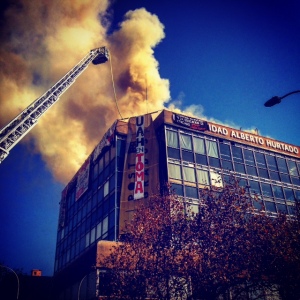One of the most pressing issues in Chile in the last decade has been the demand for free and better education. Over the years several protests have erupted led by students and their federations. When I arrived in Chile I started to feel the political effervesce in the streets. The Universidad Alberto Hurtado (where I was enrolled as part of the Summer Program) was quickly caught in the political unrest generated by the Presidential speecFh of May 21st. In that occasion president Bachelet announced an educational reform considering free university education only for a segment of the student population (the poorest 60%).
This announcement is a first step to tackle the high costs of higher education in Chile. Nonetheless, it is a measure that leaves several private universities out; the educational reform only targets those educational institutions within the Rector’s Council of Chilean Universities (Consejo de Rectores de las UniversidadesChilenas). The UAH is one of the academic institutions excluded from this body and, therefore, from this first step toward free education. It is in this context where the student federations of several private universities started a wide process of mobilization not only to protest against the narrow goals of the government but also to demand more reforms within their own universities. That’s the situation that I found during my first three weeks attending that academic institution.
I was impressed by the way the Federation’s Council (the main student body in the UAH) led the protest. Through an election the students decided to go on strike while the Federation started negotiations with the University’s authorities regarding some key demands (reduction of academic fees, elimination of tuition costs, recognition of student organizations, institutional transparency, better infrastructure, etc). The way in which the process was conducted revealed that the goal of the Federation was to press for their claims in a crucial juncture sparked by the government’s educational reform. Also, their decisions were backed by the students through permanent consultation and electoral participation. The strike was the means to put pressure on the table. Till that moment I believed the movement could achieve important concessions from the University. The democratic and peaceful way through which the Federation acted made their goals legitimate. Nonetheless, what happened next showed me the fractures within the Federation and their inability to exclude radical elements from taking the lead.
The 9th of June a small group of radical students occupied the University illegally. The Federation rejected this line of action days before in a student Assembly; nonetheless, these radicals proceeded. The 10th of June the Federation made a terrible mistake in my opinion. Instead of rejecting this kind of behavior by groups that don’t represent them, this body convoked an election to ratify this line of action. As a result, a measure that was originally imposed by a minority of students to the rest of the movement was now “legitimized” by this election, undermining the Federation’s credibility. The facilities of the University remained under the control of this group till the 17th of June. That day, the Federation suffered a damaging blow to their image. The fifth floor of one of the main buildings of the UAH (the one seen in the picture) was set on fire. While investigations still continues to determine if the fire was an accident or something deliberate, the general impression of professors and students I talked to links this radical group to the incident somehow. With the smoke still hovering around the burned infrastructure, students evacuated the building and the protest came to an end.
From this important episode that I experienced while I was a student in the UAH I concluded several things. First, the student Federation contradicted itself in several ways. They rejected all kind of actions not backed by the students. Nonetheless, the minute a radical group stepped in and imposed their agenda, the Federation not only was unable to reject them but accepted this agenda by legitimizing it through an election. Second, some of the proposals of the movement (reduction of fees and better infrastructure) were undermined by burning an entire floor that will cost several millions of pesos. Third, the credibility of the Federation was damaged by proceeding violently. If the Federation had leverage in the negotiations with the authorities they lost most of it when they were voluntarily displaced by other sectors of the student movement. Finally, the trust among students and between the Federation and the authorities of the University was shattered. It will take some time before the students can rebuild their strength and press again for their demands. Maybe this experience will serve as a lesson in the future as to the importance of avoiding being swept up in the radical rhetoric of a minority that doesn’t represent the demands of students for a free and better education.

